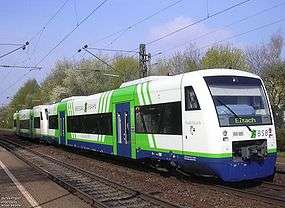Hamburg U-Bahn
 | |||
|
HafenCity Universität Station of Hamburg U-Bahn | |||
| Overview | |||
|---|---|---|---|
| Owner |
Hamburger Hochbahn AG, Verkehrsgesellschaft Norderstedt: (Norderstedt Mitte – Garstedt) | ||
| Locale | Hamburg, Norderstedt, Ahrensburg, Großhansdorf | ||
| Transit type | Rapid transit | ||
| Number of lines | 4[1][2] | ||
| Number of stations | 91[1][2] | ||
| Daily ridership | 597,260 (2013) | ||
| Annual ridership | 218 million (2013)[3] | ||
| Website | Hochbahn | ||
| Operation | |||
| Began operation | 15 February 1912[4] | ||
| Operator(s) | Hamburger Hochbahn AG | ||
| Number of vehicles |
245 trains[1][note 1] 861 cars[5] | ||
| Train length | ~120 metres (390 ft) | ||
| Headway | 5 minutes (rush hour 3 min) | ||
| Technical | |||
| System length | 104.7 km (65.1 mi)[1] | ||
| Track gauge |
1,435 mm (4 ft 8 1⁄2 in) (standard gauge) | ||
| Electrification | 750 V DC Third rail | ||
| Top speed | 80 km/h (50 mph) | ||
| |||
The Hamburg U-Bahn is a rapid transit system serving the cities of Hamburg, Norderstedt and Ahrensburg in Germany. Although technically an underground, most of the system's track length is above ground. The network is interconnected with the city's S-Bahn system, which also has underground sections. It is operated by Hamburger Hochbahn within the Hamburger Verkehrsverbund (HVV). It was opened in February 1912,[4] and comprises four lines serving 91 stations,[2] with a route length of 104 kilometres (65 mi) in 2012.[1]
History
In 1906 the Senate of Hamburg awarded a contract for the Elevated and Underground Railway to Siemens & Halske and AEG of Berlin. The first stretch was completed on 7 October 1906. This was followed in 1911 with the founding of the Hamburger Hochbahn Aktiengesellschaft (HHA). Thus Hamburg became the third German city (after Berlin, 1902 and Schöneberg, 1910) to have a U-Bahn (then known as the Elevated and Underground Railway (Hoch- und Untergrundbahn) as it is largely either elevated or in tunnels – not much at street level).
The construction of such a railway had long been discussed, meanwhile an elevated train was also considered. In 1906 a circular route was begun, connecting Hamburg Hauptbahnhof – Berliner Tor – Barmbek (earlier spelling: Barmbeck) – Kellinghusenstraße – Schlump – Landungsbrücken (earlier designation: Hafentor) – Rathaus – Hauptbahnhof with branches to the quarters of Eimsbüttel, Ohlsdorf and Rothenburgsort. On 15 February 1912 the first stretch of the future Ringbahn (Circle railway) between Rathaus station und Barmbek was inaugurated. The stretch included both underground and elevated sections.
 Übersee-
Übersee-
quartier station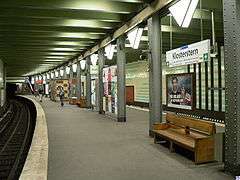 Klosterstern station
Klosterstern station- Hauptbahnhof Nord station
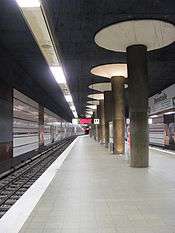 Steinstraße station
Steinstraße station
Network development
By 1915 the Ringbahn and the three spurs, from Kellinghusenstraße to Ohlsdorf, from Schlump to Hellkamp (today: disused station between Oster- and Lutterothstraße) and from central station to Rothenburgsort were completed. By 1934 the extensions from Ohlsdorf to Ochsenzoll (Langenhorner Bahn), from Kellinghusenstraße to Jungfernstieg (KellJung line), and the Walddörferbahn (Forestvillages line) from Barmbek to Großhansdorf and Ohlstedt were completed.
In 1943, during the Second World War the subway was badly damaged during 'Operation Gomorrha,' the RAF bombing of Hamburg that summer. The stretch from Hauptbahnhof to Rothenburgsort was not repaired because the district it passed through had been completely destroyed. It was five more years before the remaining network was once more completely intact.
Further additions to the network were made, starting in 1960. The KellJung line was extended via Meßberg to the central station (Hauptbahnhof). Later in 1962 the extension reached Wandsbek Markt and in 1963 Wandsbek-Gartenstadt. The total network length was 67.9 kilometres (42 mi).
The construction of a Durchmesserstrecke (diameter route) began in 1963. The plan was to connect Billstedt with Stellingen. The Eimsbüttel branch formed the western part of the line. The branch was extended up to Hagenbecks Tierpark in 1966. The existing terminus at Hellkamp was withdrawn from service in 1964 and a new station was built at Lutterothstraße further northwest.
The connection between Berliner Tor and Horner Rennbahn was opened in 1967. In the same year this eastern branch was extended to Legienstraße. Further extensions took place in 1969 to Billstedt and in 1970 towards Merkenstraße. The extension Ochsenzoll – Garstedt came into service in May 1969. Thus, the network total length reached 88.5 km (55 mi).
A new core stretch of the line U2, between Schlump and Berliner Tor, became a direct connection through the city centre. Next to be brought into service were sections from Hauptbahnhof Nord to Berliner Tor in 1968, and from Schlump (low) to Gänsemarkt in 1970, then the last section, with two new platforms on the lowest level at the station Jungfernstieg under the Binnenalster, in 1973. This station, as well as Hauptbahnhof Nord, was developed as part of the U4 line that was planned at that time.
In 1985 the section to Hagenbecks Tierpark was extended to Niendorf Markt and again in 1991 as far as Niendorf Nord. In 1990 the extension Merkenstraße – Mümmelmannsberg was opened. The line extension opened in 1996 between Garstedt and Norderstedt Mitte, which replaced the southern part of the Alsternordbahn.
In 2005 the Hamburg U-Bahn had a length of some 100.7 kilometres (63 mi), of which 40 km (25 mi) are underground. It had 89 station stops.
In 2009, the U3, beginning in Barmbek, traversed the complete ring line, thereby taking over the stretch between Berliner Tor and Barmbek, which was formerly served by the U2. In order to realise a problem-free service, a redesign of the current track layout to the west of Berliner Tor was necessary. An originally planned grade separated crossing of the two lines was realised, which was left undone before due to cost. Trains coming from the city centre leave the ring at Barmbek and continue via the viaduct stretch to Wandsbek Gartenstadt. One branch leads via the Walddörferbahn to Wandsbek-Gartenstadt, a stretch formerly served by the U2.[6]
In 2012, the U4 started operations between Billstedt and HafenCity University, sharing most of its route with the U2 and thereby increasing service on the highly used line between Berliner Tor and Billstedt.
 Map showing the network development
Map showing the network development U-Bahn station ″Baumwall″, rolling stock type DT3
U-Bahn station ″Baumwall″, rolling stock type DT3 U-Bahn ″Überseequartier″, rolling stock type DT4
U-Bahn ″Überseequartier″, rolling stock type DT4- Hamburger Hochbahn on the Vorsetzen
Future development
Abandoned projects
The eastern branch of the "Walddörferbahn" was originally intended to terminate at the station Beimoor, just to the north of Großhansdorf, in order to connect a proposed housing development to the public transport system. By the time work was abandoned, the station platform had already been finished and tracks had been laid. Today the remains of the station are used as a winter home for bats in the middle of a dry grass biotope.
Plans for a fourth line have been discussed since the 1970s. In those days it was planned for the line to lead from City Nord and Uhlenhorst via the city centre (Hauptbahnhof Nord and Jungfernstieg) and Altona to Lurup and Osdorfer Born. In order to link the green-field housing development at Osdorfer Born to the rest of the city as quickly as possible, a limited service on the stretch between Altona und Osdorfer Born was planned. Until the connection with the rest of the network was ready, it was intended to transport trains with flatbed trucks for maintenance in the service depot in Barmbek. Platforms and track beds for this stretch were completed in the stations Hauptbahnhof Nord and Jungfernstieg. Preparations for tunnel constructions were made in the area of Hamburg-Altona railway station and under the motorway A 7 in Bahrenfeld. In preparation for the junction with the U1, an extra platform was built at the new station Sengelmannstraße. All these constructions remain unused to this day. The northern surplus platform area at Hauptbahnhof Nord is currently used for the art installation Sterne by Raimund Kummer and Stefan Huber. Here several concrete stars lie over the whole platform area as if they had fallen from the sky. At the same time the southern surplus platform area is still unused in any kind of way in 2016, displaying the station as it was opened in 1968 since changes in terms of advertising spaces, station signs etc. were never applied there. However, none of those two unused platforms are accessible as they are locked with fences.
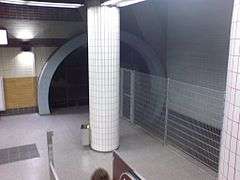 Abandoned part of Hauptbahnhof Nord
Abandoned part of Hauptbahnhof Nord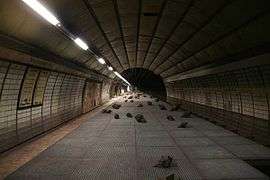 Installation Hauptbahnhof Nord
Installation Hauptbahnhof Nord- Remains of the U-Bahn station Beimoor
Project in progress
The U4 is currently being expanded south to Elbbrücken with a planned opening date at the end of 2018.[7]
In 2015 major subway extension plans were published. They include
- building a new branch from Horner Rennbahn to Horner Geest with two stations, transferring the eastern terminus of the U4 from Billstedt to the new branch terminus[8]
- adding a new station to the U1 called Oldenfelde between Farmsen and Berne[9]
- building a whole new U5 line running from Osdorfer Born in the west of Hamburg to Bramfeld in the east via Uhlenhorst, representing a modified and extended version of the old U4 plans from the 1970s. The first part of the route is intended to be built between Sengelmannstrasse and Bramfeld between 2022 und 2028.[10]
Network routes overview
The Hamburger Hochbahn plc comprises four U-Bahn lines:
| Line | Route | Trains used | First opened |
Length (km) |
Stations |
|---|---|---|---|---|---|
| U1 | Norderstedt Mitte – Jungfernstieg – Hauptbahnhof Süd – Ohlstedt / Großhansdorf | DT3, DT4 | 1914 | 55.8 km | 46 |
| U2 | Niendorf Nord – Jungfernstieg – Hauptbahnhof Nord – Mümmelmannsberg | DT4 | 1913 | 24.3 km | 25 |
| U3 | Barmbek – Circle – Barmbek – Wandsbek-Gartenstadt | DT3, DT5 | 1912 | 20.6 km | 25 |
| U4 | HafenCity Universität – Jungfernstieg – Hauptbahnhof Nord – Billstedt | DT4, DT5 | 2012 | 12.2 km | 11 |
| TOTAL: | 104.7 km | 91 | |||
| Line | Stretches from North / West to South / East |
Stops (Terminal stations in bold) |
|---|---|---|
| U1 | Langenhorner Bahn | Norderstedt Mitte – Richtweg – Garstedt – Ochsenzoll – Kiwittsmoor – Langenhorn Nord – Langenhorn Markt – Fuhlsbüttel Nord – Fuhlsbüttel – Klein Borstel – Ohlsdorf (S1, S11) |
| Ohlsdorf branch | Ohlsdorf – Sengelmannstraße – Alsterdorf – Lattenkamp – Hudtwalckerstraße – Kellinghusenstraße (U3) | |
| KellJung-Linie | Kellinghusenstraße – Klosterstern – Hallerstraße – Stephansplatz – Jungfernstieg (U2, U4, S1, S2, S3, Alster ferries) | |
| Meßberglinie | Jungfernstieg – Meßberg – Steinstraße – Hauptbahnhof Süd (U3, S1, S11, S2, S21, S3, S31) | |
| Wandsbek extension | Hauptbahnhof Süd – Lohmühlenstraße – Lübecker Straße (U3) – Wartenau – Ritterstraße – Wandsbeker Chaussee (S1, S11) – Wandsbek Markt – Straßburger Straße – Alter Teichweg – Wandsbek-Gartenstadt (U3) | |
| Walddörferbahn | Wandsbek-Gartenstadt – Trabrennbahn – Farmsen – Berne – Meiendorfer Weg – Volksdorf
| |
| Volksdorf – Buckhorn – Hoisbüttel – Ohlstedt
| ||
| Volksdorf – Buchenkamp – Ahrensburg West – Ahrensburg Ost – Schmalenbeck – Kiekut – Großhansdorf
| ||
| U2 | Niendorf extension | Niendorf Nord – Schippelsweg – Joachim-Mähl-Straße – Niendorf Markt – Hagendeel – Hagenbecks Tierpark |
| Eimsbüttel branch | Hagenbecks Tierpark – Lutterothstraße – Osterstraße – Emilienstraße – Christuskirche – Schlump (U3) | |
| Diameter route | Schlump – Messehallen – Gänsemarkt – Jungfernstieg (U1, U4, S1, S2, S3, Alster ferries) – Hauptbahnhof Nord (U4, S1, S11, S2, S21, S3, S31) – Berliner Tor (U3, U4, S1, S11, S2, S21) | |
| Billstedt branch | Berliner Tor – Burgstraße – Hammer Kirche – Rauhes Haus – Horner Rennbahn – Legienstraße – Billstedt – Merkenstraße – Steinfurther Allee – Mümmelmannsberg | |
| U3 | Ring (Circle Line) |
Barmbek (U3, S1, S11) – Saarlandstraße – Borgweg – Sierichstraße – Kellinghusenstraße (U1) – Eppendorfer Baum – Hoheluftbrücke – Schlump (U2) – Sternschanze (S11, S21, S31) – Feldstraße – St. Pauli – Landungsbrücken (S1, S2, S3, Elbe ferries) – Baumwall – Rödingsmarkt – Rathaus (Jungfernstieg: U1, U2, U4, S1, S2, S3) – Mönckebergstraße – Hauptbahnhof Süd (U1, S1, S11, S2, S21, S3, S31) – Berliner Tor (U2, U4, S1, S11, S2, S21) – Lübecker Straße (U1) – Uhlandstraße – Mundsburg – Hamburger Straße – Dehnhaide – Barmbek (U3, S1, S11) |
| Walddörferbahn | Barmbek – Habichtstraße – Wandsbek-Gartenstadt (U1) | |
| U4 | HafenCity Bahn | HafenCity Universität – Überseequartier – Jungfernstieg (U1, U2, S1, S2, S3) |
| Diameter route | Jungfernstieg – Hauptbahnhof Nord (U2, S1, S11, S2, S21, S3, S31) | |
| Billstedt branch | Hauptbahnhof Nord – Berliner Tor (U2, U3, S1, S11, S2, S21) – Burgstraße – Hammer Kirche – Rauhes Haus – Horner Rennbahn – Legienstraße – Billstedt | |
| |
Rothenburgsorter Hochbahn
|
Hauptbahnhof Süd (U1, U3, S1, S11, S2, S21, S3, S31) – Spaldingstraße – Süderstraße – Brückenstraße – Rothenburgsort (S2, S21) |
The line names U1 und U2 were introduced with the timetable change on 22 May 1966, the name U3 followed on 2 January 1967. Until the completion of the direct inner-city stretch, the future U2, on 3 June 1973, the partial services on the already completed eastern (Hauptbahnhof Nord − Berliner Tor (− Barmbek) since 29 September 1968) and western (Schlump − Gänsemarkt since 31 May 1970) sections were known as U21 and U22 respectively.
U4 project
Hamburger Hochbahn opened the new line U4 in November 2012. There had been an ongoing discussion about the costs and the benefit of this line, but the government of Hamburg decided to build it nevertheless. The underground line was dug using the same machinery as for the building of the new tunnel of the Elbe tunnel.[11]
Stations
 Joachim-Mähl-Strasse station
Joachim-Mähl-Strasse station Niendorf Markt station
Niendorf Markt station Hagendeel station
Hagendeel station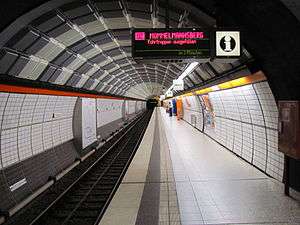 Gänsemarkt station
Gänsemarkt station Jungfernstieg station
Jungfernstieg station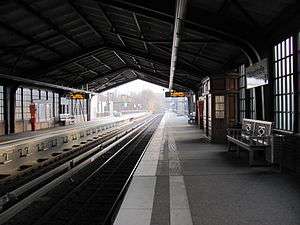 Uhlandstrasse station
Uhlandstrasse station Mundsburg station
Mundsburg station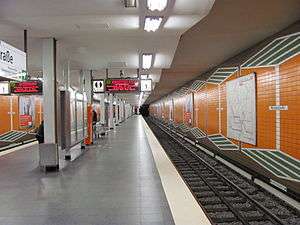 Ritterstrasse station
Ritterstrasse station Wartenau station
Wartenau station Stephansplatz station
Stephansplatz station
U-Bahn stations at Hamburg Hauptbahnhof
Hamburg Hauptbahnhof is a central junction with the mainline railway, and, due to the confluence of all U-Bahn lines and all S-Bahn lines, an important interchange for suburban public transport as well.
Tunnels for the first underground railway were constructed at the same time as the Hauptbahnhof itself. The tunnels run underneath the mainline tracks, which are themselves below street level. The current U3 stops at this station, which, for more clarity, is now known as Hauptbahnhof Süd. There is also an underground pedestrian tunnel parallel to the U3 circle line tunnel, which, until its closure in 1991, allowed a quick connection to the mainline platforms.
The unusual width of the vaulted station is due to the fact that it originally housed four tracks; the Rothenburgsort branch, which was destroyed in World War II and never rebuilt, used to begin here. The tunnels for the U1 were driven under the mainline railway next to the U3 tunnels in 1959. The platform for the U1 lies directly south to the U3 and is accessible via the same station entrances.
The opening of the line U2 (U21 in 1969) lead to the construction of a further underground station Hauptbahnhof Nord to serve it. The station is 30 metres (98 ft) below the surface; in the direction of the Jungfernstieg station, the tunnels pass under the Aussenalster, an artificial lake. The two outer platforms remain unused since their construction and were originally intended for a proposed U-Bahn line between Altona/Lurup and Winterhude/City Nord.
Operating company
The system is owned and operated by the Hamburger Hochbahn (HHA), except the Garstedt – Norderstedt Mitte section, which is owned by the Verkehrsgesellschaft Norderstedt (VGN) but also operated by the Hamburger Hochbahn.
Service information
Services operate with a 5- or 10-minute frequency with the exception of the northeastern peripheral branches of U1 that have a 10 or 20-minute frequency. Since the timetable change in December 2004 the U-Bahn operates an all-night, 20-minute service interval on Friday and Saturday nights. From Sunday to Thursday the U-Bahn operates from 4 am to about 1 am.
Rolling stock
The Hamburg U-Bahn uses standard gauge electric multiple units that run on third rail with 750 volts DC. The current fleet mostly consists of trains that had been developed from 1950s to 1980s. In 2012, newly developed trains were introduced. A typical Hamburg U-Bahn train is made up of six (U3 line), eight or nine cars (all other lines). Trains with four cars can also be found on weekend or in the night.
Current rolling stock
Type DT3
The Type DT3 was introduced in 1968 to shorten the journey time on the U1 line. A total of 127 units were built from 1966 to 1971. 68 units were refurbished from 1994 to 2001 and received a more modern design. Six units still have their original red 1960s front, they were equipped with LZB for semi-automatic operation between 1981 and 1985. The other 60 units were scrapped due to structural issues and replacement by new DT4 trains between 1995 and 2003. Between 2008 and 2011, most of the 68 remaining units received an interior refurbished once again. As the DT3 is currently the oldest train type in the system, new DT5 trains are replacing them since 2013 and retirement has started in 2015. 10 units are going to be preserved as an operational reserve for about 10 more years: They will receive propulsion modifications, a modern interior design and structural issues of the wearing bodies will be fixed.[12]
Type DT4
The Type DT4 was introduced in 1988 to replace the Type DT1, most of the DT2 trains and some DT3 trains. The Type DT4 came with a more futuristic design, reduced noise, increased safety and greater economy than the older trains. A total of 126 units were built from 1988 to 2005. Currently, the older DT4 trains are being refurbished as the oldest units are almost 30 years old already.
Type DT5
The Type DT5 was introduced in 2012 to completely renew the current rolling stock. By 2016, 51 of 108 planned units have been built. The Type DT5 is the first type of U-Bahn trains in Hamburg with an air-condition and transitions between the cars.
 Type DT3-LZB
Type DT3-LZB- Type DT3-E (refurbished)
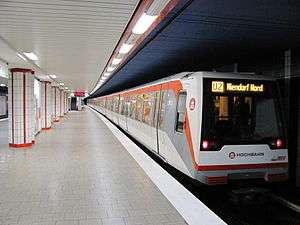 Type DT4
Type DT4- Type DT5
Former rolling stock
Type T/TU
The HHA Type T was introduced with the Hamburg U-Bahn itself. Nearly 400 cars were built from 1911 to 1943. Some cars were destroyed in world war II; these cars were rebuilt from 1947 to 1949 and signed as Type TU1. To raise the economy, another 100 cars were rebuilt from 1959 to 1961 and signed as TU2. The passenger service for the T/TU-type ended in 1970, some cars were converted to working service cars and were used until the 1980s. Five cars are preserved for museum rides, four of them in service and one awaiting restoration.
Type DT1
The Type DT1 was used from 1958 to 1991 in passenger service. A total of 100 cars (or 50 units) were produced. The Type DT1 had a much better acceleration than the T-type; however, their high energy consumption left the Hamburger Hochbahn in dissatisfaction with the new trains, moving them into rush-hour service only in the 1970s. Most units got scrapped after their retirement while some cars were converted into working trains (retired in 2005) and three units were preserved for museum rides (two of them still awaiting restoration).
Type DT2
The Type DT2 was introduced in 1962 to replace the Type T trains. After the experiences with the heavy DT1 trains they were constructed as light-weight cars with weaker engines to save energy. A total of almost 200 units were built from 1960 to 1966. Most of them also were refurbished in the 1980s and 1990s. The refurbished units were called DT2-E. After the official retirement in 2004, 15 units remained in service as an operational reserve. Those were retired in November 2015 after being replaced by new DT5 trains. One non-refurbished unit is preserved for museum rides but has not been sent into restoration yet (2016).
 Type T
Type T- Type TU1
- Type DT1
 Type DT2 (original)
Type DT2 (original)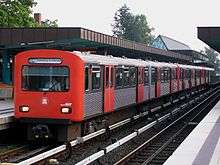 Type DT2-E (refurbished)
Type DT2-E (refurbished)
See also
Notes
- ↑ Number of vehicles without maintenance trains.
References
- 1 2 3 4 5 "Die HOCHBAHN auf einen Blick" [A View of the U-Bahn] (in German). Hamburger Hochbahn. 2012. Retrieved 2013-09-30.
- 1 2 3 "HOCHBAHN - Annual Report 2012 - THINKING FURTHER! TURNING VISIONS INTO REALITY" (PDF). hochbahn.de (via: http://www.hochbahn.de/wps/portal/de/home/hochbahn/unternehmen/die_hochbahn/unternehmen_unternehmensbericht/). Hamburger Hochbahn. 2012. p. 4. Retrieved 2013-09-30. External link in
|website=(help) - ↑ http://www.hochbahn.de/wps/portal/de/home/hochbahn/unternehmen/die_hochbahn/unternehmen_auf_einen_blick?1dmy¤t=true&urile=wcm:path:/wps/wcm/connect/hochbahn_content/home/hochbahn/unternehmen/die_hochbahn/unternehmen_auf_einen_blick
- 1 2 "Historie der HOCHBAHN" [History of the U-Bahn] (in German). Hamburger Hochbahn. 2013. Retrieved 2013-09-30.
- ↑
- ↑ "Wegen Linientausch: U-Bahnen fahren nicht" (in German). Hamburger Abendblatt. 2009-06-23. Retrieved 2009-08-18.
- ↑ "Extension of the U4 (in German)". Extension of the U4. Hamburger Hochbahn. Retrieved 2016-09-19.
- ↑ "U4-Verlängerung Horner Geest". www.hochbahn.de. Retrieved 2016-09-19.
- ↑ "U1-Haltestelle Oldenfelde". www.hochbahn.de. Retrieved 2016-09-19.
- ↑ "U5 Ost Bramfeld - City Nord". www.hochbahn.de. Retrieved 2016-09-19.
- ↑ Website U4 project, see external links
- ↑ "Hamburgs älteste U-Bahnen werden modernisiert" (in German). 2016-06-14. Retrieved 2016-09-19.
External links
| Wikimedia Commons has media related to Hamburg U-Bahn. |
- Hamburger Hochbahn official website Operator of the Hamburger U-Bahn
- Die Geschichte der Hamburger Hochbahn Book by André Loop
- Current and historical Plans for the U4

.png)
